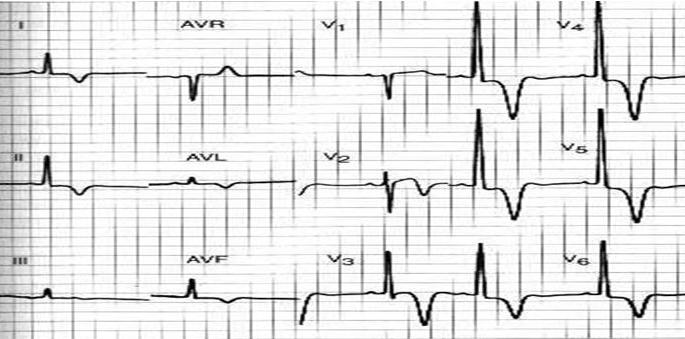Sandbox/HCM
Editor-In-Chief: C. Michael Gibson, M.S., M.D. [1]; Associate Editor(s)-in-Chief: Mugilan Poongkunran M.B.B.S [2]
Overview
Hypertrophic cardiomyopathy (HCM), is a heterogeneous cardiac muscle disease characterized by unexplained LV hypertrophy associated with nondilated ventricular chambers in the absence any underlying disease that is capable of producing hypertrophy, or without overt hypertrophy in the presence of the HCM genetic substrate (genotype positive/phenotype negative or subclinical HCM). HCM is caused by autosomal dominant mutations in sarcomere genes which encode components of the contractile apparatus of the heart. The clinical manifestations of HCM individuals depends upon the site and extent of cardiac hypertrophy, having asymptomatic normal life expectancy without disability to severe symptomatic presentation due to LV outflow obstruction, heart failure, myocardial ischemia, arrhythmia, mitral regurgitation or sudden cardiac death. The diagnosis of HCM is made with cardiac imaging (echocardiography or cardiac MRI), showing maximal LV wall thickness ≥ 15 mm in adults or thickness ≥ 2 SD above the mean for age, sex, body size in children and with genetic testing. The management of HCM involves risk stratification to ascertain which patients are at risk for sudden cardiac death, treatment of comorbidities, ICDs for secondary or primary prevention, pharmacological therapy to control heart failure, surgical options for progressive and drug-refractory heart failure symptoms due to LV outflow tract (LVOT) obstruction and heart transplantation for systolic dysfunction with severe unrelenting symptoms.
Classification
Obstructive form of HCM
Defined when peak instantaneous LV outflow gradient ≥30 mm Hg under basal (resting) conditions. or with physiologic provocation.
Non-obstructive form of HCM
Defined when peak instantaneous LV outflow gradient <30 mm Hg at rest and with provocation.
Causes
Life Threatening Causes
Hypertrophic cardiomyopathy can be a life-threatening condition and must be treated as such irrespective of the underlying cause.
Common Causes
- Congenital: Autosomal dominant mutation in genes that encode sarcomere proteins or sarcomere-associated proteins.
- Beta myosin heavy chain
- Myosin binding protein C
- Troponin T
- Troponin I
- Alpha tropomyosin
- Actin
- Regulatory light chain
- Essential light chain
- Actinin
- Myozenin
FIRE: Focused Initial Rapid Evaluation
A Focused Initial Rapid Evaluation (FIRE) should be performed to identify patients in need of immediate intervention.
Boxes in red color signify that an urgent management is needed.
Complete Diagnostic Approach to Hypertrophic Obstructive Cardiomyopathy
A complete diagnostic approach should be carried out after a focused initial rapid evaluation is conducted and following initiation of any urgent intervention.
Treatment
Complete Diagnostic Approach to Mitral Regurgitation
A complete diagnostic approach should be carried out after a focused initial rapid evaluation is conducted and following initiation of any urgent intervention.
Abbreviations: EKG: Electrocardiogram; LVOT: Left ventricle outflow tract;
Characterize the symptoms: ❑ Asymptomatic:
❑ Fatigue
❑ Paroxysmal nocturnal dyspnea (suggestive of heart failure)
❑ Palpitations: Due to any of the following
❑ Syncope or pre-syncope: Due to any of the following
❑ Abdominal distension (suggestive of right heart failure) | |||||||||||||||||||||||||||
Obtain a detailed history: ❑ Exercise history: ❑ Past medical history:
❑ Family history:
| |||||||||||||||||||||||||||
Examine the patient: Vital signs:
Skin: Cardiovascular system:
❑ Parasternal lift (suggestive of significant mitral regurgitation and/or pulmonary hypertension)
Auscultation:
❑ Murmur:
Respiratory system: Abdominal system: Neurological system: | |||||||||||||||||||||||||||
Order electrocardiogram:
❑ Prominent abnormal Q waves, particularly in the inferior (II, III, and aVF) and lateral leads (I, aVL, and V4-V6)  Order transthoracic echocardiography (TTE) (Level of Evidence: B):
Order lab tests: Other tests:
❑ Twenty four hour ambulatory (Holter) electrocardiographic monitoring:
| |||||||||||||||||||||||||||
Consider differential diagnosis:
❑ Hypertensive heart disease | |||||||||||||||||||||||||||
Treatment
| HCM patients | |||||||||||||||||||||||||||||||||||||||||||||||||||||
Does the patient has signs of hemodynamic insatbility? | |||||||||||||||||||||||||||||||||||||||||||||||||||||
| Yes | No | ||||||||||||||||||||||||||||||||||||||||||||||||||||
Initiate resuscitative measures: ❑ Secure airway
❑ Consider ICU admission | Treat Comorbidities: ❑ Hypertension | ||||||||||||||||||||||||||||||||||||||||||||||||||||
Initiate medical therapy: Intravenous phenylephrine: | Does the patient has left ventricular outflow tract (LVOT) obstruction? | ||||||||||||||||||||||||||||||||||||||||||||||||||||
| Yes | No | ||||||||||||||||||||||||||||||||||||||||||||||||||||
| Does the patient has heart failure symptoms or angina? | Does the patient has heart failure symptoms or angina? | ||||||||||||||||||||||||||||||||||||||||||||||||||||
| Yes | No | Yes | No | ||||||||||||||||||||||||||||||||||||||||||||||||||
Initiate medical therapy: Beta blockers:
| Annual clinical evaluation: ❑ | Determine the systolic function (LVEF) | Annual clinical evaluation: ❑ Perform Genetic testing (Class IIa, Level of Evidence: B)
❑ | ||||||||||||||||||||||||||||||||||||||||||||||||||
| Does the patient have persistent symptoms despite medical therapy? | LVEF < 50% | LVEF ≥ 50% | |||||||||||||||||||||||||||||||||||||||||||||||||||
| Yes | No | Click here for hear failure resident survival guide | Initiate medical therapy: ❑ Beta blockers | ||||||||||||||||||||||||||||||||||||||||||||||||||
| Acceptable surgical candidate? | Follow-up | ||||||||||||||||||||||||||||||||||||||||||||||||||||
| Yes | No | ||||||||||||||||||||||||||||||||||||||||||||||||||||
| Surgical momectomy or alcohol ablation | Alcohol ablation or pacing | ||||||||||||||||||||||||||||||||||||||||||||||||||||
Do's
However in equivocal cases, cardiac catheterization with isoproterenol infusion may further aid in eliciting a provocable gradient (82). Otherwise, routine invasive cardiac catheterization to document outflow gradients is necessary only when there are discordant data from Doppler echocardiography and the physical examination
Don'ts
Provocation with dobutamine infusion during Doppler echocardiography is no longer recommended as a strategy to induce outflow gradients in HCM.
- Don't perform genetic testing for relatives when the index patient does not have a definitive pathogenic mutation (Class IIb Level of Evidence:B).